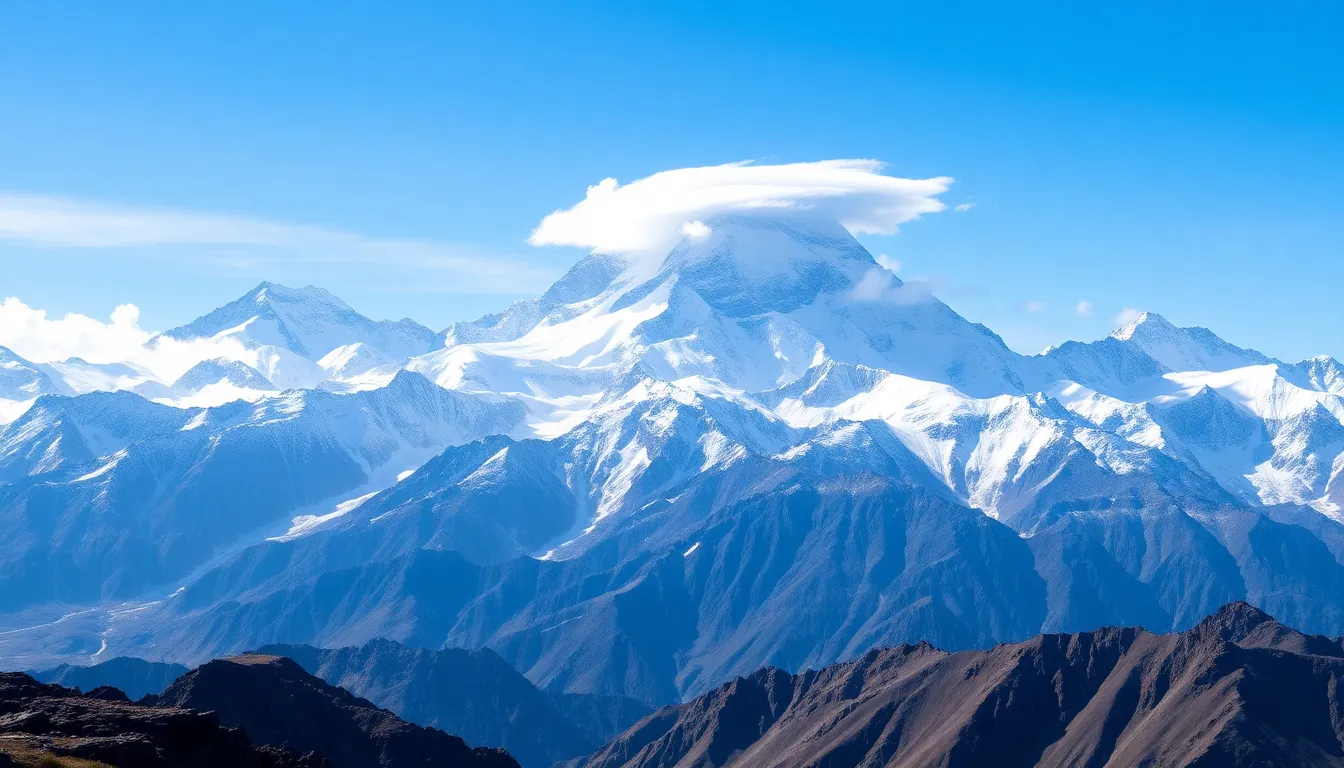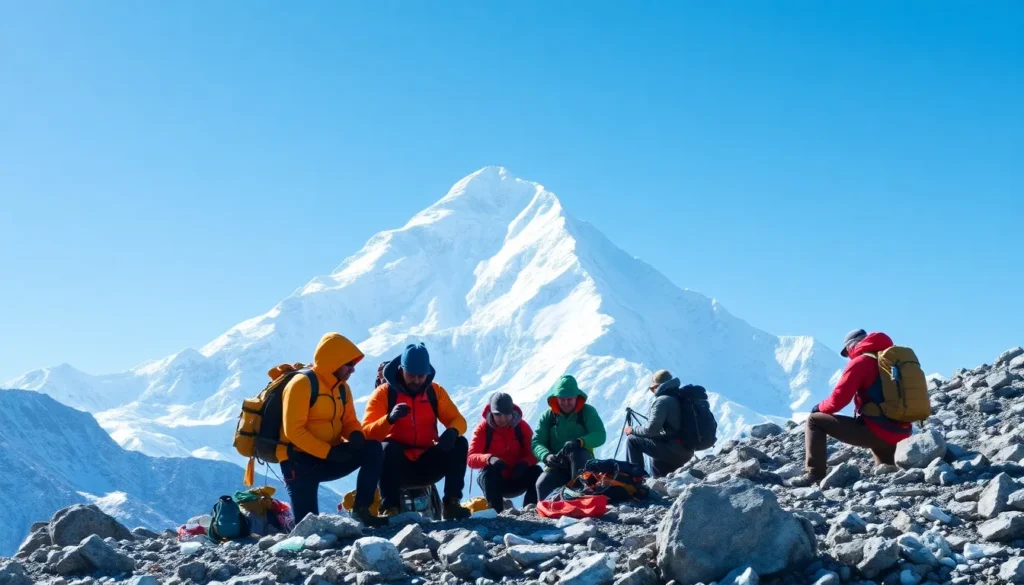Table of Contents
ToggleMount Everest, the towering giant of the Himalayas, is a destination that sparks dreams of adventure and awe. But before you pack your climbing gear and start practicing your best “I’m on top of the world” pose, you might want to know where this majestic peak actually resides. Spoiler alert: it’s not in your backyard!
Overview of Mount Everest
Mount Everest, the highest peak in the world, stands at 29,029 feet above sea level. Its extraordinary height and breathtaking scenery attract adventurers from around the globe.
Significance of Mount Everest
Mount Everest serves as a powerful symbol of achievement in the climbing community. Climbing it represents the ultimate challenge for mountaineers, embodying human resilience and determination. The mountain holds cultural importance for the Sherpa people, who consider it sacred. Additionally, Everest’s unique environment provides valuable insights into climate change and alpine ecosystems.
Popularity Among Climbers
Popularity among climbers continues to rise, with thousands attempting to summit each year. Each climbing season sees an influx of both seasoned professionals and novices. Weather conditions, route accessibility, and advancements in equipment contribute to Everest’s attraction. More than 800 successful summits occurred in a single year, showcasing its allure. This peak’s challenge draws national and international media attention, further fueling climbers’ ambitions.
Geographical Location

Mount Everest occupies a unique geographical position in the world, straddling two countries: Nepal and the Tibet Autonomous Region of China. This extraordinary mountain’s southern slope lies entirely within Nepal, while the northern slope extends into Tibet.
Countries That Share Mount Everest
Nepal and China serve as the two nations that share Mount Everest. Nepal’s southern face features the most popular climbing routes, while Tibet presents a less-traveled path known as the North Ridge. Climbers in Nepal typically gain access through the Sagarmatha National Park, which offers infrastructure and support. On the Chinese side, climbers face unique regulations and permits that can vary annually.
The Himalayas: A Brief Overview
The Himalayas represent one of the world’s tallest mountain ranges, spanning five countries: India, Nepal, Bhutan, China, and Pakistan. This vast stretch of mountains houses numerous peaks, including K2 and Kangchenjunga. The region experiences significant tectonic activity, resulting in continuous growth and geological changes. Rich biodiversity exists within the Himalayas, supporting various ecosystems and unique wildlife. The range also plays a crucial role in local cultures, serving as landmarks and spiritual sites.
Mount Everest and Nepal
Mount Everest plays a crucial role in the identity of Nepal, deeply woven into the fabric of its culture and economy.
Cultural Importance in Nepal
Cultural significance thrives around Mount Everest. The Sherpa community, residing in the region, views Everest as a sacred entity, holding deep spiritual meaning. Celebrations and rituals, often tied to the mountain, reflect this reverence. The Sherpas’ unique traditions and languages contribute to the rich tapestry of Himalayan culture. Festivals honoring local deities often take place within sight of the peak, reinforcing the bond between the people and their environment. Furthermore, tales of ascent and resilience shape the narratives passed down through generations.
Tourism and Economy Impact
Tourism drives Nepal’s economy significantly, with Mount Everest serving as a primary attraction. Thousands trek through Sagarmatha National Park each year, contributing millions to local businesses. Tour guides and porters support climbing expeditions, providing jobs and income for families. The climbing season brings international adventurers, enhancing cross-cultural exchange and showcasing Nepal’s natural beauty. Infrastructure improvements, including accommodation and transportation, emerge from the growing demand. Such developments stimulate economic growth, empowering communities and promoting sustainable initiatives in the region.
Mount Everest and Tibet
Mount Everest’s northern slope, located in the Tibet Autonomous Region of China, presents a unique cultural landscape and climbing experience. This region’s deep-rooted traditions and beliefs shape its significance.
Cultural Significance in Tibet
Mount Everest holds profound cultural importance for the Tibetan Buddhist community. Local beliefs regard the mountain as a manifestation of spiritual enlightenment. Mountaineering is not merely a challenge; it signifies a pilgrimage for many, fostering a connection with the sacred. Ancestors and deities are venerated through various rituals and ceremonies conducted in its honor. Additionally, this reverence serves as a reminder of nature’s majesty and the need for environmental preservation. Tibetan culture emphasizes respect for the mountain’s spiritual identity, intertwining their heritage with the Everest experience.
Accessibility for Climbers in Tibet
Climbing Everest from the Tibet side requires navigating specific regulations and securing permits through the Chinese government. Numerous agencies assist climbers in managing these logistical aspects, which can change annually. The route from Tibet allows access to the North Ridge, fewer crowds attract those preferring solitude. Infrastructure in the region includes base camps and trails, but they may lack the same level of development found in Nepal. Adventure seekers must also consider the climate, with weather conditions influencing accessibility. Guided tours provide critical support, ensuring climbers have proper equipment and knowledge of local regulations.
Environmental Considerations
Environmental considerations surrounding Mount Everest involve significant challenges and responsibilities. The influx of climbers and trekkers impacts the surrounding ecosystem and local communities.
Impact of Tourism
Tourism has transformed Mount Everest into a popular destination for adventurers and nature enthusiasts. Thousands traverse the region annually, driving support for local economies. However, increased foot traffic leads to environmental degradation, littering, and waste management issues. In 2019, climbers reportedly left behind nearly 26,000 pounds of trash on Everest. Crowding on popular routes can impact wildlife behavior and strain natural resources. Preservation of the mountain’s fragile ecosystem remains crucial as climbing seasons continue to draw record numbers.
Conservation Efforts
Various organizations and local governments are implementing conservation efforts to protect Mount Everest. Initiatives focus on waste removal programs and sustainable practices during climbing seasons. In 2018, Nepal introduced a mandatory trash deposit for climbers, requiring them to bring back specific amounts of waste. Partnerships with NGOs help to promote responsible tourism and educate climbers on minimizing their environmental impact. Preservation of local traditions and ecosystems is becoming vital as the balance between tourism and conservation continues to evolve.
Mount Everest stands as a monumental testament to human ambition and the natural world. Nestled between Nepal and Tibet it offers diverse climbing experiences and rich cultural significance. As climbers and trekkers flock to its majestic heights the balance between tourism and environmental conservation becomes increasingly vital. The mountain’s allure continues to inspire both adventure seekers and those drawn to its spiritual essence. Preserving Everest’s beauty and integrity is essential for future generations to experience the wonder it embodies.







